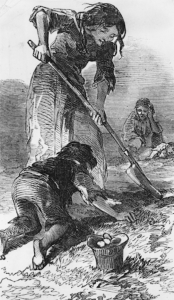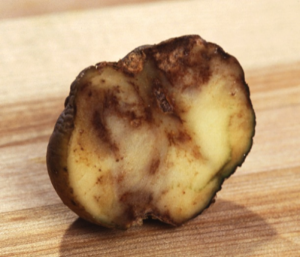What happened?
- England and Ireland have a long, complex history of conflict that persists to this day. Beginning in the 1100s, England tried many times to establish settlements in Ireland, taking local land and disenfranchising the Irish people. These settlements, especially the first successful one, the Ulster plantation in present-day Northern Ireland, which was established in 1609, were a great source of conflict between the English and Scottish settlers and the Irish inhabitants. In addition to the social and political oppression of the native inhabitants by the settlers, the Protestant English and Scottish were culturally very different from the Catholic Irish, even though their religious beliefs are fairly similar.
- In the 1690s, tensions increased when 10% of the Scottish population migrated to Northern Ireland to escape widespread famine caused by restrictions on food imports by the French, the continued failure of crops, and the failure of the cod fisheries.
- In the late 1700s, most of Ireland’s population, which had nearly doubled recently, relied on potatoes as the primary staple. In 1845, potato blight began to spread through the country, causing a famine that killed a million people in just a few years.

A mother and her children looking for potatoes in a field during the Irish potato famine; Illustrated London News (from Alan, 2013, NBCNews).

A potato infected with Phytophthora infestans, the fungus that causes potato blight (Stromberg, 2013, Smithsonian).
How is this related to climate?
- While many factors were at play in the development of conflict between Irish Catholics and English Protestants, climate may have exacerbated it. The Little Ice Age, a period of widespread cooling and an average drop in global temperatures from around 1300 to 1850 brought heavy snow and frost to areas of Europe that had previously been warmer, including Ireland. Such cold weather caused crop failure and poor harvests, which triggered disastrous, widespread famines that then contributed to social and political unrest.
- Documents such as the Annals of Loch Cé, one of the most important written records of medieval Irish history, describe snowfall in the middle of summer in the mid-1500s. Catholics blamed the Reformation of 1542 in Ireland for bad weather events. They believed that bad growing seasons were dishonorable to the patron saint, further fueling religious tensions with the Protestants.
- The summer of 1641 was one of the coldest summers on record in Europe since the 1400s. This led to poor harvests and fueled the Irish Rebellion of 1641, in which Irish Catholics rose against English Protestant settlers in October of that year. The Irish blamed Protestants for failed crops and poor harvests, driven by fears of religious persecution. A severe cold snap occurred during this conflict, and thousands of Protestants died of exposure. This conflict had great consequences for centuries to come, including the efforts of Oliver Cromwell, an English military and political leader, to establish Protestant control in Ireland in the 1650s.
- The colder conditions of the Little Ice Age allowed the potato to thrive, making it a good crop to feed large numbers of people. As the Little Ice Age came to a close in the 1840s, temperatures rose and conditions became warm and wet, perfect for Phytophthora infestans, the fungus that causes potato blight. The year of 1845 was exceptionally warm, allowing for the spread of blight that devastated potato crops and resulted in famine during the following several years. In total the Irish potato famine, as it is known today, killed about a million people and forced another 1 million to emigrate.
Further Exploration
- Ireland, which had previously been a lordship ruled by the kings of England, became the Kingdom of Ireland in 1542 – a client state of England (and later, Great Britain) under the influence of the English Parliament. Despite this government decision, the Irish population generally remained devout Roman Catholics, while most of the English population was Protestant. These tensions between the Irish Catholics and English Protestants were a precursor to larger, serious and long-lasting conflicts, that erupted in The Thirty Years’ War (1618 to 1648), which was also exacerbated by climate change.
- The effects of the conflict between England and Ireland can still be seen today. The Irish people are divided over whether or not Northern Ireland should be a part of the United Kingdom. Many of the people living in Northern Ireland are descended from the English and Scottish settlers and therefore want to retain close ties with the United Kingdom. However, many other people in the rest of the country want Northern Ireland to become part of the Republic of Ireland.
References and additional resources
- Boyle, A. “Scientists Identify the Mystery Killer behind Ireland’s Potato Famine.” NBCNews. 2013. www.nbcnews.com/science/scientists-identify-mystery-killer-behind-irelands-potato-famine-6C10057354.
- History.com Editors. “Irish Potato Famine.” History. 2017. www.history.com/topics/immigration/irish-potato-famine.
- “How Did England Try to Control Ireland in the 16th Century?” YouTube, uploaded by Lagan History, 2016. www.youtube.com/watch?v=crP-Pw9WPXI.
- Meigs, S. A. Reformations in Ireland: Tradition and Confessionalism (1st ed). Palgrave Macmillan, 1997.
- O’Toole, F. “Deposition on Atrocities, 1641.” The Irish Times. 2019. https://www.irishtimes.com/news/environment/deposition-on-atrocities-1641-1.501674.
- Pappas, S. “Irish Potato Blight Originated in South America.” LiveScience. 2017. www.livescience.com/57363-irish-potato-blight-originated-in-south-america.html.
- Parker, G. “Crisis and Catastrophe: The Global Crisis of the Seventeenth Century Reconsidered.” The American Historical Review, vol. 113, no. 4, 2008, pp. 1053–79. http://www.jstor.org/stable/30223245.
- Parker, G. “Lessons From the Little Ice Age.” The New York Times. 2014. https://www.nytimes.com/2014/03/23/opinion/sunday/lessons-from-the-little-ice-age.html.
- Prothero, D. R. and Dott, R. H. Evolution of the Earth (8th ed). New York, McGraw-Hill Education, 2010.
- Stromberg, J. “Scientists Finally Pinpoint the Pathogen That Caused the Irish Potato Famine.” Smithsonian. 2013. www.smithsonianmag.com/science-nature/scientists-finally-pinpoint-the-pathogen-that-caused-the-irish-potato-famine-71084770/.
- The Editors of Encyclopaedia Britannica. “Thirty Years’ War.” Encyclopaedia Britannica. 2020. www.britannica.com/event/Thirty-Years-War.
- “What Was the Ulster Plantation?” YouTube, uploaded by Lagan History, 2016. www.youtube.com/watch?v=l67EsiJxUPo&feature=emb_rel_pause.
